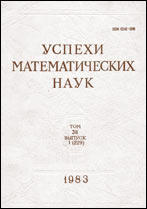|
This article is cited in 89 scientific papers (total in 91 papers)
The various definitions of the derivative in linear topological spaces
V. I. Averbukh, O. G. Smolyanov
Abstract:
The object of this article is to give a survey of the existing definitions of the operation of differentiation in linear topological spaces (l.t.s.) and to show the connections between them.
There are at present more than a score of definitions of the derivative of a map of one l.t.s. into another. These definitions are stated in what are superficially completely different ways, and the authors who proposed new definitions have not as a rule concerned themselves with the relations between the new definitions and those already known. This leads to an impression of chaos.
The two existing surveys of the theory of differentiation in l.t.s. do not alter this impression. The first, due to Hyers, is a part of an article on l.t.s. which appeared in 1945 and is out of date. The second, due to Keller, was published in 1964 but is not complete. In the first place, it is far from giving all the definitions known at that time; in the second place, it considers only locally convex l.t.s; and in the third place, the connections between the definitions discussed are not described fully enough.
It turns out – and this is really remarkable – that in fact all the definitions for the derivative that have been proposed up to now can be grouped into a small number of classes, each consisting of equivalent definitions, and that there is a simple scheme of mutual relations between these classes.
The present article follows on our article [1]. However, the latter had a different object: to give a systematic account of differential calculus in l.t.s. The account was based on one definition of the derivative, which seemed to us the most successful. (In any case many results do not depend on what definition is taken as basis.) A short survey of some definitions of the derivative was given in the introduction to [1], and a table of connections between them was given without proofs. Thus, this article and [1] complement one another and together constitute a united whole.
An idea of the contents of the article can be obtained from the chapter headings. We make a few remarks.
We begin with a historical sketch of the development of the idea of the derivative from 1887 to the present. Then follows a list of all definitions that have been proposed (Table 1). Next, this list is divided into classes of mutually equivalent definitions. The enumeration of inequivalent definitions is in Table 2. The connections between them are shown in a diagram. Table 3 gives an enumeration of counterexamples, which demonstrate that no implications are valid except those in the diagram. All the l.t.s. discussed are assumed to be separated l.t.s. on the field of real numbers.
Apart from the contents of the elementary university courses, all that is needed for the understanding of this article is a knowledge of the rudimentary facts of the theory of l.t.s., for example those in Chapter 9 of the book by Kantorovich and Akilov (1959).
Received: 12.02.1968
Citation:
V. I. Averbukh, O. G. Smolyanov, “The various definitions of the derivative in linear topological spaces”, Russian Math. Surveys, 23:4 (1968), 67–113
Linking options:
https://www.mathnet.ru/eng/rm5654https://doi.org/10.1070/RM1968v023n04ABEH003770 https://www.mathnet.ru/eng/rm/v23/i4/p67
|


| Statistics & downloads: |
| Abstract page: | 1622 | | Russian version PDF: | 1122 | | English version PDF: | 122 | | References: | 91 | | First page: | 1 |
|




 Contact us:
Contact us: Terms of Use
Terms of Use
 Registration to the website
Registration to the website Logotypes
Logotypes








 Citation in format
Citation in format 
